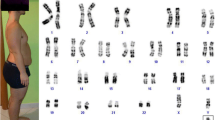Summary
The origin of meiotic nondisjunction of the extra chromosomes X and 21 was studied in a patient with the karyotype 48,XXY,+21 using DNA polymorphisms. The extra chromosome X was the result of paternal first meiotic nondisjunction of X and Y. The extra chromosome 21 was derived from the mother. The meiotic error in the mother most probably occurred in meiosis II. Thus, this is a combination caused by the chance occurrence of two independent events.
Similar content being viewed by others
References
Antonarakis SE, Lewis JG, Adelsberger PA, Petersen MB, Schinzel A, Binkert F, Pangalos C, Raoul O, Chakravarti A, Hafez M, Cohen MM, Roulston D, Schwartz S, Mikkelsen M, Tranebjaerg L, Greenberg F, Hoar DI, Warren AC, Metaxotou C, Bartsokas C (1991) Parental origin of the extra chromosome in trisomy 21 revisited: DNA polymorphism analysis suggests maternal origin in 95% of cases. N Engl J Med (in press)
Baker BS, Carpenter ATC, Esposito MS, Esposito RE, Sandler L (1976) The genetic control of meiosis. Annu Rev Genet 10:53–135
Burmeister M, Cox DR, Myers RM (1990) Dinucleotide repeat polymorphism located at D21S120 in 21q11.2. Nucleic Acids Res 18:49–69
Ford CJ, Jones KW, Miller OJ, Mittwoch U, Penrose LS, Ridler M, Shapiro A (1959) The chromosomes in a patient showing both mongolism and the Klinefelter syndrome. Lancet I:709–710
Fraser N, Boyd Y, Craig I (1989) Isolation and characterization of a human variable copy number tandem repeat at Xcen-p11. 22. Genomics 5:144–148
Hamamy HA, Ai-Hakkak ZS, Al-Taha S (1990) Consanguinity and the genetic control of Down syndrome. Clin Genet 37:24–29
Hassold TJ, Jacobs PA (1984) Trisomy in man. Annu Rev Genet 18:69–97
Hassold TJ, Takaesu N (1989) Analysis of nondisjunction in human trisomic spontaneous abortions. In: Hassold TJ, Epstein CJ (eds) Molecular and cytogenetic studies of non-disjunction. Proceedings of the 5th Annual National Down Syndrome Society Symposium, New York 1988. Liss, New York, pp 115–134
Heilig R, Oberlé I, Arveiler B, Hanauer A, Vidaud M, Mandel JL (1988) Improved DNA markers for efficient analysis of fragile X families. Am J Med Genet 30:543–550
Ikonen RS, Lindlöf M, Janas MO, Simola KOJ, Millington-Ward A, Chapelle A de la (1989) Coincident maternal meiotic nondisjunction of chromosomes X and 21 without evidence of autosomal asynapsis. Hum Genet 83:235–238
Jacobs P, Hassold T, Harvey J, May K (1989) The origin of sex chromosome aneuploidy. In: Hassold TJ, Epstein CJ (eds) Molecular and cytogenetic studies of non-disjunction. Proceedings of the 5th Annual National Down Syndrome Society Symposium, New York 1988. Liss, New York, pp 135–151
Mandel JB, Willard HF, Nussbaum RL, Romeo G, Puck JM, Davies KE (1989) Report of the committee on the genetic constitution of the X chromosome. (10th International Workshop on Human Gene Mapping) Cytogenet Cell Genet 51:384–437
Middlesworth W, Bertelson C, Kunkel LM (1985) An RFLP detecting single copy X-chromosome fragment, dic56, from Xp22-Xpter [HGM8 assignment no DXS 143]. Nucleic Acids Res 13:5723
Mikkelsen M, Fischer G, Stene J, Stene E, Petersen E (1976) Incidence study of Down's syndrome in Copenhagen, 1960–1971:with chromosome investigation. Ann Hum Genet 40:177–182
Perwein E (1984) Incidence of Klinefelter's syndrome. In: Bandmann HJ, Breit R (eds) Klinefelter's syndrome. Springer, Berlin Heidelberg New York, pp 8–11
Petersen MB, Schinzel AA, Binkert F, Tranebjaerg L, Mikkelsen M, Collins FA, Economou EP, Antonarakis SE (1991) Use of short sequence repeat DNA polymorphisms after PCR amplification to detect the parental origin of the additional chromosome 21 in Down syndrome. Am J Hum Genet 48:65–71
Petersen MB, Slaugenhaupt SA, Lewis JG, Warren AC, Chakravarti A, Antonarakis SE (1991) A genetic linkage map of 27 markers on human chromosome 21. Genomics 9:407–419
Saura R, Longy M, Sautarel M, Renouil M, Sandler B (1983) ouble trisomie et inversion pericentrique transmise [48,XXY, +21,inv(22)]. Effet interchromosomique. Ann Génét (Paris) 26:181–183
Stene J, Stene E, Mikkelsen M (1984) Risk of chromosome abnormality at amniocentesis following a child with a non-inherited chromosome aberration. Prenat Diagn 4:81–95
Author information
Authors and Affiliations
Rights and permissions
About this article
Cite this article
Lorda-Sanchez, I., Petersen, M.B., Binkert, F. et al. A 48,XXY,+21 Down syndrome patient with additional paternal X and maternal 21. Hum Genet 87, 54–56 (1991). https://doi.org/10.1007/BF01213092
Received:
Revised:
Issue Date:
DOI: https://doi.org/10.1007/BF01213092




